

古脊椎动物学报 ›› 2021, Vol. 59 ›› Issue (1): 64-80.DOI: 10.19615/j.cnki.1000-3118.200819
• • 上一篇
孙吉嘉1,2,3, 张贝1,2,3, 陈曦4, 邓里5, 文军5, 同号文1,2,3,*( )
)
收稿日期:2020-04-28
出版日期:2021-01-20
发布日期:2021-01-20
通讯作者:
*tonghaowen@ivpp.ac.cn基金资助:
SUN Ji-Jia1,2,3, ZHANG Bei1,2,3, CHEN Xi4, DENG Li5, WEN Jun5, TONG Hao-Wen1,2,3,*( )
)
Received:2020-04-28
Published:2021-01-20
Online:2021-01-20
摘要:
江西萍乡杨家湾2号洞是发育在二叠系灰岩中的溶洞,其中充填了晚更新世的黏土和沙砾堆积;自2015年至今已经挖掘6次,出土了万余件哺乳动物化石标本,其中野猪牙齿化石约占49%, 代表目前我国更新世野猪牙齿化石最为丰富的地点。将杨家湾2号洞出土的猪科动物牙齿化石(尤其是犬齿和第三臼齿)与我国南方特有的化石种裴氏猪(Sus peii)和小猪(Sus xiaozhu)及盐井沟出土的野猪化石进行了牙齿形态学比较研究和一系列数据分析(包括散点图、回归分析、变异系数分析和线性判别分析等); 所有雄性下犬齿均属于野猪型,数据分析结果也表明,杨家湾2号洞出土的猪科化石可全部归入野猪种(Sus scrofa); 尽管雄性下犬齿和上第二及下第三臼齿测量数据的变异范围很大,但都在野猪的变异范围之内。在此基础上,还利用杨家湾2号洞出土的野猪第三臼齿化石进行了种内变异研究,上、下第三臼齿的散点图各自聚为两大聚集区,这一结果很可能是由性别差异所导致而非不同属种混合。中国南方地区早更新世之后的猪科动物基本只有野猪一种,这与毗邻的东南亚地区不同;东南亚的猪科动物十分多样,并且绝大多数具有爪哇疣猪型犬齿。
中图分类号:
孙吉嘉, 张贝, 陈曦, 邓里, 文军, 同号文. 江西萍乡杨家湾2号洞晚更新世野猪化石研究. 古脊椎动物学报, 2021, 59(1): 64-80.
SUN Ji-Jia, ZHANG Bei, CHEN Xi, DENG Li, WEN Jun, TONG Hao-Wen. New fossils of Late Pleistocene Sus scrofa from Yangjiawan Cave 2, Jiangxi, China. Vertebrata Palasiatica, 2021, 59(1): 64-80.

Fig. 1 Types of cross sections of the lower canines of different male suids A. scrofic type; B. intermediate type; C. verrucosic type (modified from Fujita et al., 2000); D-E. Sus peii; F. S. xiaozhu (modified from Han, 1987); G. S. scrofa from Yangjiawan Cave 2 a. width of the posterior face; b. width of the labial (external) face; c. width of the lingual (internal) face
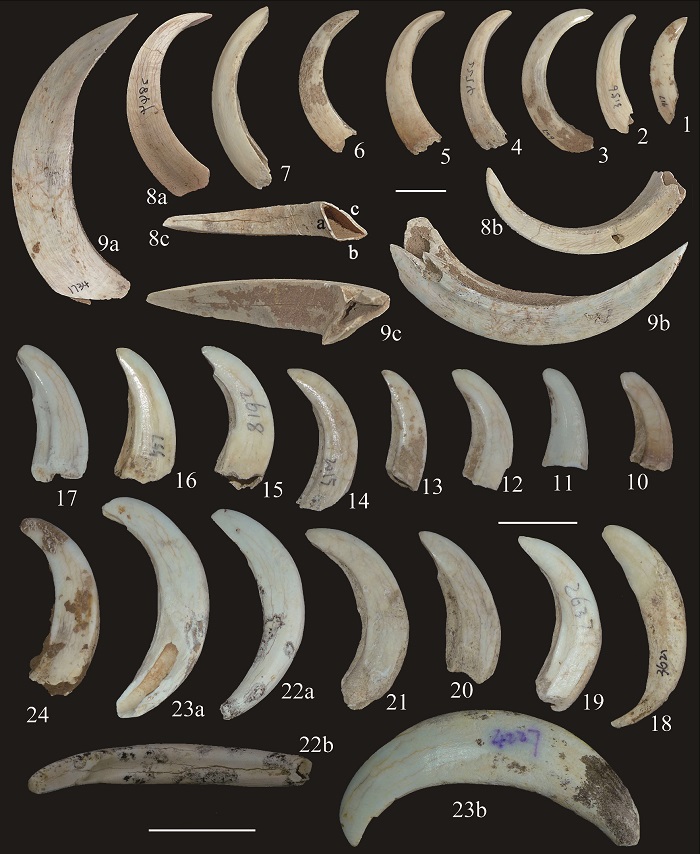
Fig. 2 Lower canines of both sexes of Sus scrofa from Yangjiawan Cave 2 1-3, 6, 9. male right lower canines (IVPP V 26768.14-18); 4-5, 7-8. male left lower canines (horizontally flipped) (V 26768.19-22); 10, 17, 20-24. female left lower canine (horizontally flipped) (V 26768.23-29); 11-16, 18-19. female right lower canine (V 26768.30-37) 1-7, 8a, 9a, 23b. anterior (or lingual) views; 8b, 9b, 10-24. inferior (or labial) views; 8c, 9c, 22b. posterior views. Scale bars=2 cm
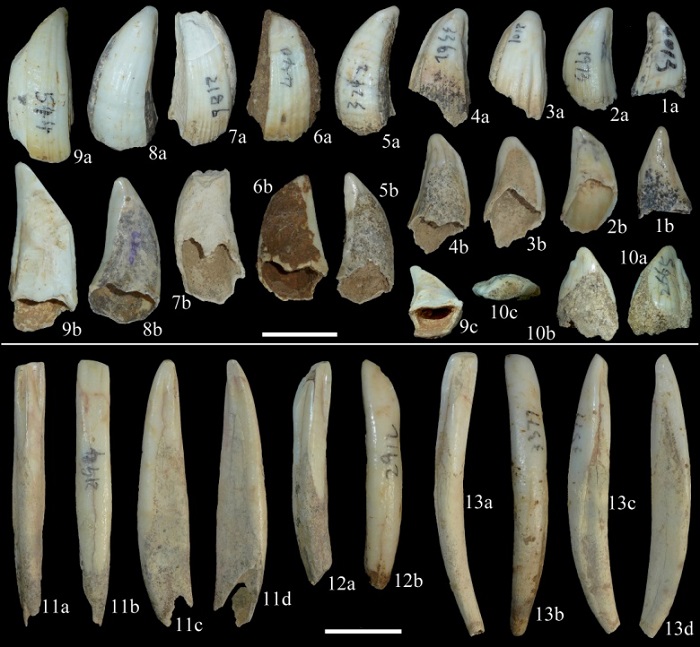
Fig. 3 Upper canines and lower incisors of Sus scrofa from Yangjiawan Cave 2 1, 6-7. male right upper canines (IVPP V 26768.1-3); 2-5, 8-9. male left upper canines (V 26768.4-9); 10. female left upper canine (V 26768.10); 11. left i1 (V 26768.11); 12-13. left i2s (V 26768.12-13). 1a-10a. inferior views; 1b-10b. superior views; 9c. basal view; 10c. crown view; 11a-13a. lingual views; 11b-13b. vestibular views; 11c, 13c. distal views; 11d, 13d. mesial views. Scale bars=2 cm
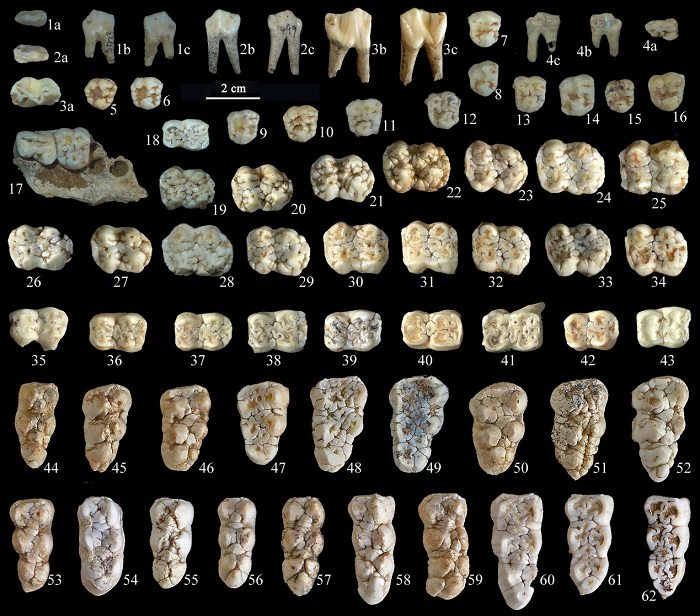
Fig. 4 Selected cheek teeth of Sus scrofa from Yangjiawan Cave 2 1. left p2 (IVPP V 26768.38); 2. left p3 (V 26768.39); 3. left p4 (V 26768.40); 4. left P2 (V 26768.41); 5-16. right P4s (V 26768.42-53); 17. partial left maxilla with P3-4 (V 26768.54); 18. right m1 (V 26768.55); 19. left M1 (V 26768.56); 20-34. left M2s (V 26768.57-71); 35-43. left m2s (V 26768.72-80); 44-52. left M3s (V 26768.81-89); 53-62. left m3s (V 26768.90-99) 1a, 2a, 3a, 4a, 5-62. occlusal views; 1b, 2b, 3b, 4b. buccal views; 1c, 2c, 3c, 4c. lingual views
| n | Variation | Average | SD | CV | R2 | P value | |||
|---|---|---|---|---|---|---|---|---|---|
| S. xiaozhu ( | M3 | L | 37 | 16.3‒22.0 | 19.4 | 1.37 | 7.05 | 0.65 | <0.01 |
| W | 11.4‒16.6 | 13.8 | 1.19 | 8.62 | |||||
| m3 | L | 25 | 16.2‒26.8 | 21.6 | 2.76 | 12.78 | 0.85 | <0.01 | |
| W | 8.3‒14.3 | 11.3 | 1.33 | 11.73 | |||||
| S. peii ( | M3 | L | 30 | 34.6‒42.0 | 38.4 | 1.94 | 5.05 | 0.07 | 0.17 |
| W | 21.3‒25.5 | 23.6 | 0.96 | 4.07 | |||||
| m3 | L | 58 | 35.0‒44.3 | 38.5 | 1.96 | 5.09 | 0.37 | <0.01 | |
| W | 16.2‒22.9 | 19.0 | 1.13 | 5.94 | |||||
| S. scrofa (YJW Cave 2) | M2 | L | 106 | 15.3‒28.1 | 23.3 | 1.71 | 7.35 | 0.17 | <0.01 |
| W | 11.7‒21.4 | 18.7 | 1.53 | 8.18 | |||||
| m2 | L | 117 | 20.1‒29.2 | 23.0 | 1.38 | 6.01 | 0.41 | <0.01 | |
| W | 13.1‒18.5 | 15.3 | 0.93 | 6.09 | |||||
| M3 | L | 76 | 29.1‒41.0 | 35.1 | 2.47 | 7.04 | 0.54 | <0.01 | |
| W | 19.3‒23.0 | 20.2 | 1.40 | 6.92 | |||||
| m3 | L | 133 | 32.1‒49.1 | 38.7 | 2.89 | 7.48 | 0.30 | <0.01 | |
| W | 13.0‒20.8 | 17.1 | 1.17 | 6.84 |
Table 1 Data of Sus xiaozhu, S. peii and S. scrofa (mm)
| n | Variation | Average | SD | CV | R2 | P value | |||
|---|---|---|---|---|---|---|---|---|---|
| S. xiaozhu ( | M3 | L | 37 | 16.3‒22.0 | 19.4 | 1.37 | 7.05 | 0.65 | <0.01 |
| W | 11.4‒16.6 | 13.8 | 1.19 | 8.62 | |||||
| m3 | L | 25 | 16.2‒26.8 | 21.6 | 2.76 | 12.78 | 0.85 | <0.01 | |
| W | 8.3‒14.3 | 11.3 | 1.33 | 11.73 | |||||
| S. peii ( | M3 | L | 30 | 34.6‒42.0 | 38.4 | 1.94 | 5.05 | 0.07 | 0.17 |
| W | 21.3‒25.5 | 23.6 | 0.96 | 4.07 | |||||
| m3 | L | 58 | 35.0‒44.3 | 38.5 | 1.96 | 5.09 | 0.37 | <0.01 | |
| W | 16.2‒22.9 | 19.0 | 1.13 | 5.94 | |||||
| S. scrofa (YJW Cave 2) | M2 | L | 106 | 15.3‒28.1 | 23.3 | 1.71 | 7.35 | 0.17 | <0.01 |
| W | 11.7‒21.4 | 18.7 | 1.53 | 8.18 | |||||
| m2 | L | 117 | 20.1‒29.2 | 23.0 | 1.38 | 6.01 | 0.41 | <0.01 | |
| W | 13.1‒18.5 | 15.3 | 0.93 | 6.09 | |||||
| M3 | L | 76 | 29.1‒41.0 | 35.1 | 2.47 | 7.04 | 0.54 | <0.01 | |
| W | 19.3‒23.0 | 20.2 | 1.40 | 6.92 | |||||
| m3 | L | 133 | 32.1‒49.1 | 38.7 | 2.89 | 7.48 | 0.30 | <0.01 | |
| W | 13.0‒20.8 | 17.1 | 1.17 | 6.84 |
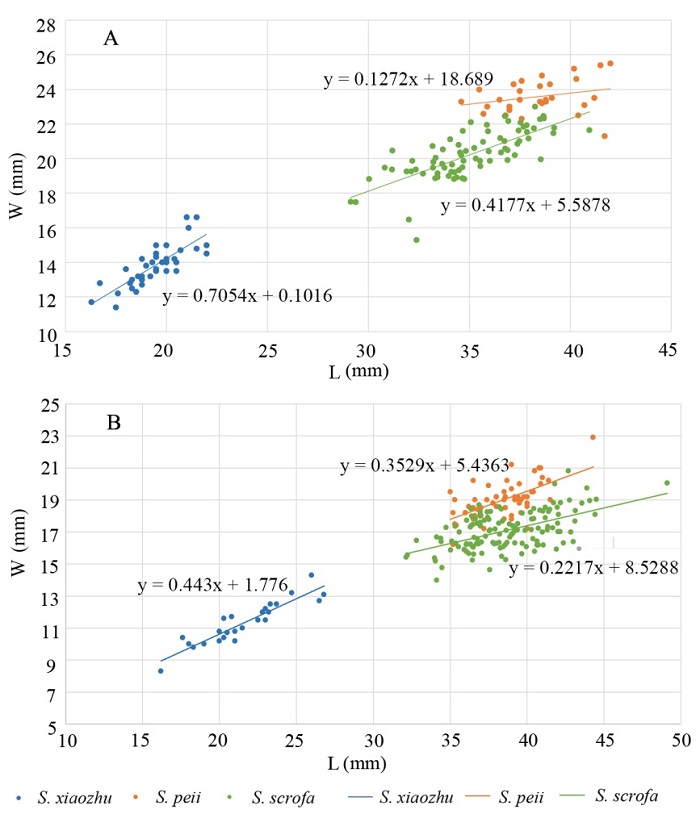
Fig. 5 Scatter plots of length versus width of the third molars of Sus xiaozhu and S. peii from Liucheng Gigantopithecus Cave and S. scrofa from Yangjiawan Cave 2 A. M3; B. m3. The data of S. xiaozhu and S. peii are from Han, 1975
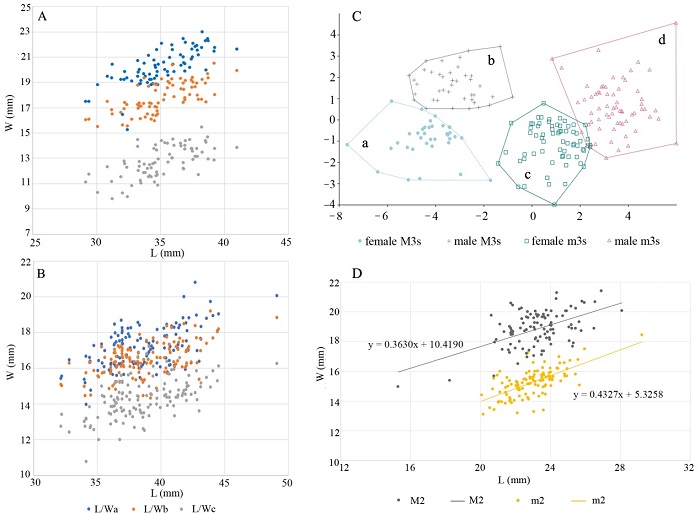
Fig. 6 Scatter plots of length versus width and linear discriminant analysis (LDA) of selected teeth of Sus scrofa from Yangjiawan Cave 2 A, B. total length versus lobe’s width of M3 (A) and m3 (B); C. linear discriminant analysis of the third molars: the data points of M3 separate into two distinct clusters, which probably represent females (a) and males (b) respectively, the dots of m3 also form two distinct groups, which probably represent females (c) and males (d) respectively; D. total length versus width of M2 and m2 L/Wa. total length versus first lobe’s width; L/Wb. total length versus second lobe’s width; L/Wc. total length versus third lobe’s width
| 1 | Albarella U, Dobney K, Rowley-Conwy P , 2015. Size and shape of the Eurasian wild boar (Sus scrofa), with a view to the reconstruction of its Holocene history. Environ Archaeol, 14:103-136 |
| 2 | Allen G M , 1940. Mammals of China and Mongolia. New York: American Museum of Natural History. Part 2. 1114-1126 |
| 3 | Bökönyi S , 1974. History of domestic mammals in Central and Eastern Europe. Technol Cult, 17:108 |
| 4 | Chen G F , 2004. Artiodactyla. In: Zheng S H ed. Jianshi Hominid Site. Beijing: Science Press. 1-412 |
| 5 |
Cherin M, Sorbelli L, Crotti M et al., 2018. New material of Sus strozzii (Suidae, Mammalia) from the Early Pleistocene of Italy and a phylogenetic analysis of suines. Quat Sci Rev, 194:94-115
DOI URL |
| 6 | Colbert E H, Hooijer D A , 1953. Pleistocene mammals from the limestone fissures of Szechwan, China. Bull Am Mus Nat Hist, 102:1-134 |
| 7 | Dong W , 2008. Early Pleistocene suid (mammal) from the Dajushan, Huainan, Anhui Province (China). Vert PalAsiat, 46:233-246 |
| 8 | Ducrocq S , 1994. An Eocene peccary from Thailand and the biogeographical origins of the artiodactyl family Tayassuidae. Palaeontology, 37:765-779 |
| 9 | Ducrocq S, Chaimanee Y, Suteethorn V et al., 1998. The earliest known pig from the Upper Eocene of Thailand. Palaeontology, 41:147-156 |
| 10 |
Endo H, Kurohmaru M, Hayashi Y , 1994. An osteometrical study of the cranium and the mandible of the Ryuku wild pig in Iriomote Island. J Vet Med Sci, 56(5):855-860
DOI URL PMID |
| 11 |
Evin A, Dobney K, Schafberg R et al., 2015. Phenotype and animal domestication: a study of dental variation between domestic, wild, captive, hybrid and insular Sus scrofa. BMC Evol Biol, 15:1-16
DOI URL PMID |
| 12 | Flannery K V , 1983. Early pig domestication in the fertile crescent: a retrospective look. In: Young Jr T C, Smith P E L, Mortensen P et al. ed. The Hilly Flanks. Essays on the Prehistory of Southwestern Asia Presented to Robert J. Braidwood. Chicago: Oriental Institute of the University of Chicago. 163-188 |
| 13 |
Frantz L, Meijaard E, Gongora J et al., 2016. The evolution of Suidae. Annu Rev Anim Biosci, 4:61-85
DOI URL PMID |
| 14 | Fujita M, Kawamura Y, Murase N , 2000. Middle Pleistocene wild boar remains from NT Cave, Niimi, Okayama Prefecture, West Japan. J Geosci Osaka City Univ, 43:57-95 |
| 15 | Gentry A W, Hooker J J , 1988. The phylogeny of the Artiodactyla. In: Benton M J ed. The Phylogeny of the Tetrapods. Oxford: Clarendon. 235-272 |
| 16 | Groves C , 1981. Ancestors for the pigs: taxonomy and phylogeny of the genus Sus. Tech Bull, 3:1-96 |
| 17 | Groves C , 2007. Current views on taxonomy and zoogeography of the genus Sus. In: Albarella U, Dobney K, Ervynck A et al. eds. Pigs and Humans: 10,000 years of Interaction. Oxford: Oxford University Press. 15-29 |
| 18 | Groves C, Grubb P , 1993. The suborder Suiformes. In: Oliver W ed. Pigs, Peccaries, and Hippos: Status Survey and Conservation Action Plan. Gland, Switzerland: International Union for Conservation of Nature and Natural Resources (IUCN). 1-4 |
| 19 | Hammer Ø, Harper D A T, Paul D R , 2001. Past: paleontological statistics software package for education and data analysis. Palaeontol Electron, 4:1-9 |
| 20 | Han D F , 1987. Artiodactyla fossils from Liucheng Gigantopithecus cave in Guangxi. Mem Inst Vertebr Paleont Paleoanthrop, Acad Sin, 18:135-208 |
| 21 | Han D F, Xu C H, Yi G Y , 1975. Quaternary mammalian fossils from Bijiashan, Liuzhou, Guangxi. Vert PalAsiat, 13:250-256 |
| 22 | Hardjasasmita H S , 1987. Taxonomy and phylogeny of the Suidae (Mammalia) in Indonesia. Scrip Geol, 85:1-68 |
| 23 | Harrison D L, Bates P J J , 1968. The Mammals of Arabia. London: Ernest Benn Limited. 308-313 |
| 24 | Heude P M , 1888. Etude sur les Suilliens. Chapter I. Mém Hist Nat Emp Chinois, 2(3):52-64 |
| 25 | Higham C , 1968. Size trends in prehistoric European domestic fauna, and the problem of local domestication. Acta Zool Fenn, 120:1-21 |
| 26 |
Hou S K, Su D F, Kelley J et al., 2018. New fossil suid specimens from the terminal Miocene hominoid locality of Shuitangba, Zhaotong, Yunnan Province, China. J Mammal Evol, 26:557-571
DOI URL |
| 27 |
Ide Y, Nakahara T, Nasu M et al., 2013. Postnatal mandibular cheek tooth development in the miniature pig based on two-dimensional and three-dimensional X-ray analyses. Anat Rec, 296(8):1247-1254
DOI URL |
| 28 | Jiangzuo Q G, Zhang B, Deng L et al., 2018. Fossil Carnivora (Mammalia) from Yangjiawan Cave 2, Pingxiang, Jiangxi, with remarks about the tooth identification of Quaternary Carnivores. In: Dong W ed. Proceedings of the 16th Annual Meeting of the Chinese Society of Vertebrate Paleontology. Beijing: China Ocean Press. 119-146 |
| 29 | Keuling O, Podgórski T, Monaco A et al., 2017. Chapter 21: Eurasian wild boar Sus scrofa (Linnaeus, 1758). In: Melletti M, Meijaard E eds. Ecology, Conservation and Management of Wild Pigs and Peccaries. Cambridge: Cambridge University Press. 202-233 |
| 30 | Liu L P , 2001. Eocene suoids (Artiodactyla, Mammalia) from Bose and Yongle Basin, China, and the classification and evolution of the Paleogene suoids. Vert PalAsiat, 39:115-128 |
| 31 |
Liu W H, Dong W, Zhang L M et al., 2017. New material of Early Pleistocene Sus (Artiodactyla, Mammalia) from Yangshuizhan in Nihewan Basin, North China. Quat Int, 434:32-47
DOI URL |
| 32 | McKenna M C, Bell S K , 1997. Classification of Mammals Above the Species Level. New York: Columbia University Press. 1-631 |
| 33 |
Mayer J J, Brisbin I L Jr , 1988. Sex identification of Sus scrofa based on canine morphology. J Mammal, 69:408-412
DOI URL |
| 34 | Mayer J J, Brisbin I L Jr, 1991. Wild Pigs in the United States: Their History, Morphology, and Current Status. Athens: University of Georgia Press. 1-313 |
| 35 | Mayer J J, Brisbin I L Jr, 1993. Distinguishing Feral Hogs from introduced wild boar and their hybrids: a review of past and present efforts. In: Hanselka C W, Cadenhead J F eds. Feral Swine: a Compendium for Resource Managers. San Angelo: Texas Agricultural Extension Service. 28-49 |
| 36 | Mayer J J, Novak J M, Brisbin I L Jr, 1998. Evaluation of molar size as a basis for distinguishing wild boar from domestic swine: employing the present to decipher the past. In: Nelson S M ed. Ancestors for the Pigs: Pigs in Prehistory. Philadelphia: University of Pennsylvania Press. 39-53 |
| 37 | Milne-Edwards A , 1871. Descriptions of new species: in footnotes. In David Journal d'un voyage en Mongolie et en Chine fait en 1866-68. Nouv Arch Mus Hist Nat Paris Bull, 7:91-93 |
| 38 | Payne S, Bull G , 1988. Components of variation in measurements of pig bones and teeth and the use of measurements to distinguish wild from domestic pig remains. Archaeozoology, 2:27-66 |
| 39 | Qi G Q, Lin Z Y, An J Y , 2006. Animal remains from Dadiwan site. In: The Gansu Provincial Institute of Cultural Relics and Archaeology ed. Dadiwan in Qin’an—Report on Excavations at a Neolithic Site (Vol II). Beijing: Cultural Relics Publishing House. 861-910 |
| 40 | Stampfli H R , 1983. The fauna of Jarmo with notes on animal bones from Matarrah, the Amuq, and Karim Shahir. In: Braidwood L S, Braidwood R J, Howe B et al. eds. Prehistoric Archaeology Along the Zagros Flanks. Chicago: Oriental Institute of the University of Chicago. 431-483 |
| 41 | Tong H W, Deng L, Chen X et al., 2018. Late Pleistocene proboscideans from Yangjiawan caves in Pingxiang of Jiangxi, with discussions on the Stegodon orientalis-Elephas maximus assemblage. Vert PalAsiat, 56:306-326 |
| 42 | van der Made J , 1996. Listriodontinae (Suidae, Mammalia), their evolution, systematics and distribution in time and space. Contrib Tert Quat Geol, 33:3-254 |
| 43 | Wilkinson A F , 1976. The Lower Miocene Suidae of Africa. In: Savage R J G, Coryndon S C eds. Fossil Vertebrates of Africa, Vol 4. London/New York: Academic Press. 173-282 |
| 44 | Young C C , 1932. On the Artiodactyla from the Sinanthropus site at Choukoutien. Palaeont Sin, Ser C, 8(2):1-100 |
| 45 | Zeuner F E , 1963. A History of Domesticated Animals. London: Hutchinson. 1-560 |
| 46 |
Zhang B, Zou S L, Chen X et al., 2017. Mammalian fossils from Yangjiawan Cave 2 of Pingxiang, Jiangxi Province and the indication of age. Quat Sci, 37:155-165
DOI URL |
| 47 |
Zhang B, Chen X, Tong H W , 2018. Tooth remains of Late Pleistocene moschid and cervid (Artiodactyla, Mammalia) from Yangjiawan and Fuyan Caves of southern China. Quat Int, 490:21-32
DOI URL |
| 48 | Zou S L, Chen X, Zhang B et al., 2016. Preliminary report on the Late Pleistocene mammalian fauna from Shangli County, Pingxiang, Jiangxi Province. Acta Anthropol Sin, 35:109-120 |
| [1] | 武瑞, 涂黎, 韩凤禄. 陕西鄂尔多斯盆地中三叠统一离片椎类牙齿化石. 古脊椎动物学报, 2022, 60(1): 54-58. |
| [2] | 马姣, 王元, 金昌柱, 张瀚文, 胡耀武. 序列取样的稳定同位素研究示踪中国晚更新世亚洲象的摄食行为. 古脊椎动物学报, 2019, 57(3): 225-240. |
| [3] | 毛方园, 郑晓廷, 王孝理, 王元青, 毕顺东, 孟津. 侏罗纪燕辽生物群贼兽类牙齿发育双出齿和异时发育的证据. 古脊椎动物学报, 2019, 57(1): 51-76. |
| [4] | 周亚纯, 舒柯文, 张福成. 中生代鸟类牙齿的退化及其可忽略的体重效应. 古脊椎动物学报, 2019, 57(1): 38-50. |
| [5] | 同号文,邓 里, 陈 曦,张 贝,文 军. 江西萍乡上栗杨家湾洞晚更新世长鼻类化石:兼论东方剑齿象–亚洲象组合. 古脊椎动物学报, 2018, 56(4): 306-326. |
| [6] | 张颖奇,金昌柱,王 元,Alejandra ORTIZ,何 锴,Terry HARRISON. 广西崇左更新世长臂猿化石新材料. 古脊椎动物学报, 2018, 56(3): 248-263. |
| [7] | 同号文,陈 曦,张 贝,王法岗. 河北泥河湾及隆化新发现原始牛化石. 古脊椎动物学报, 2018, 56(1): 69-92. |
| [8] | 毛方园,李传夔,孟津,李茜,白滨,王元青,张兆群,赵凌霞,王伴月. 牙齿釉质显微结构术语简介和规范汉语译名的建议. 古脊椎动物学报, 2017, 55(4): 347-366. |
| [9] | 王世骐,邓 涛. 雌性偏好促进象型类的性别异时进化. 古脊椎动物学报, 2016, 54(1): 51-66. |
| [10] | 莫进尤,徐 星. 江西晚白垩世大型兽脚类恐龙牙齿. 古脊椎动物学报, 2015, 53(1): 63-72. |
| [11] | 白 滨,王 旭. 小哺乳动物化石牙齿釉质碳、氧同位素测试方法简介及应用前景. 古脊椎动物学报, 2013, 51(3): 242-251. |
| [12] | Lucja Fostowicz-Frelik, 李传夔,孟 津,王元青. 内蒙古额尔登敖包中始新世戈壁兔(哺乳纲:兔形目)新材料. 古脊椎动物学报, 2012, 50(3): 219-236. |
| [13] | 陈少坤,邓涛,何文,陈善勤. 记临夏盆地维氏大唇犀一牙齿异常个体. 古脊椎动物学报, 2011, 49(2): 223-228. |
| [14] | 徐 星 , 詹姆斯•克拉克. 中国西部准噶尔盆地侏罗纪石树沟组的巨型兽脚类恐龙. 古脊椎动物学报, 2008, 46(2): 157-160. |
| [15] | 董 为, 李占扬. 河南许昌灵井遗址的晚更新世偶蹄类. 古脊椎动物学报, 2008, 46(1): 31-50. |
| 阅读次数 | ||||||
|
全文 |
|
|||||
|
摘要 |
|
|||||